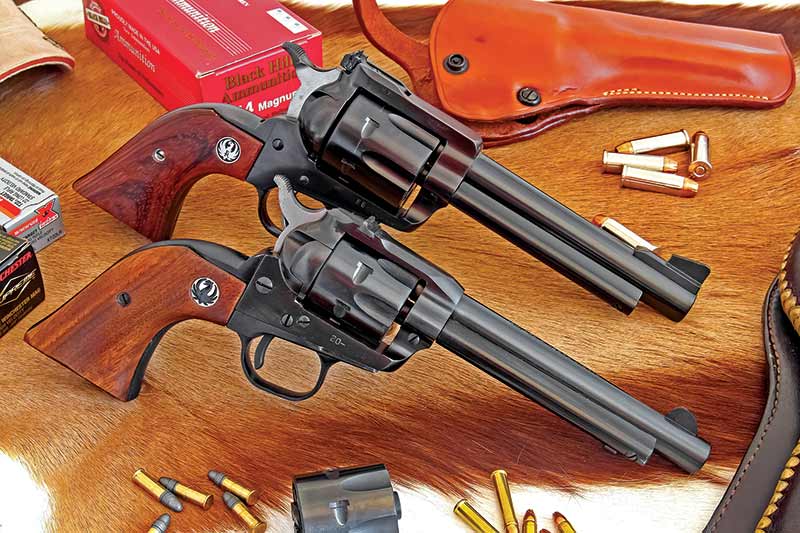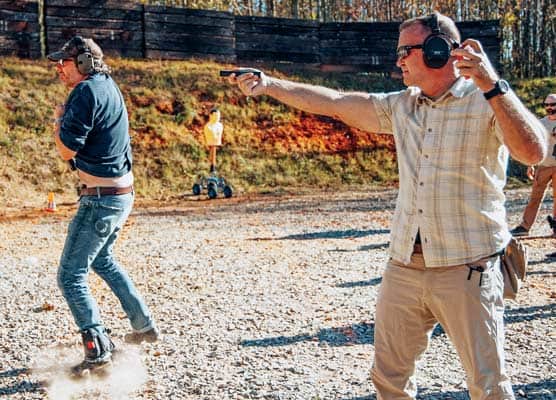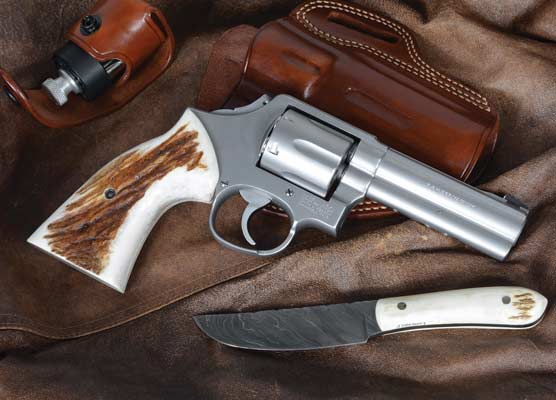Recoil Science
Recoil and muzzle blast are the two biggest hurdles to overcome in learning to shoot well. If guns didn’t recoil and make loud noise, learning would be so much easier. But until we can go to our local gun store and purchase a phased plasma rifle, recoil and blast are realities we need to manage.
Recoil Physics
Recoil moves the barrel away from the point of aim. Since we mostly shoot the gun vertically with the grip below the gun, the muzzle moves up as the gun is fired. Movement begins as the bullet starts to move — the muzzle is rising as the bullet is traveling down the barrel. With handguns of light to moderate recoil, muzzle rise while the bullet is in the bore is negligible.
With powerful cartridges, it’s significant. Revolvers like the Ruger Super Blackhawk .44 Magnum have tall front sights. When the sights are aligned on target, the muzzle is actually pointing below the target. The muzzle rises as the bullet travels down the bore, and if you’ve sighted it in properly, the bullet hits where it’s supposed to.
Recoil also has a torque effect, rotating the gun in the direction opposite the rifling twist. Generally, the effect is mild enough we are hardly aware, but you can feel it when shooting a big bore with a lighter grip.
Recoil is why instructors stress the importance of a consistent grip, both in terms of hand position on the gun and how firmly it is gripped. Consistency is less critical with light-recoiling guns, which is why most people shoot their best with heavy target .22 pistols. At the other end of the scale, guns with heavy recoil such as .44 Magnums, .454 Casull and .500 S&W are as sensitive to grip pressure as a fine violin.
Recoil velocity and recoil energy can be calculated, based on bullet weight, muzzle velocity, powder charge weight and gun weight. Comparison charts provide useful information but don’t tell the whole story. Recoil is also affected by the size, shape, materials and location of the grip, and by devices such as muzzle brakes and suppressors.
Shooter Impact
How recoil is perceived varies with individuals. Hand and arm strength are factors, although I believe muscle tone, overall fitness level, and shooting technique are more important. I’ve seen junior shooters, well short of their full growth and strength, handle centerfires in competition with complete control and aplomb.
Many new shooters (and some not so new) are, perhaps subconsciously, afraid of recoil and muzzle blast. Such apprehension is perfectly understandable. I feel the key to overcoming such fears is to never let the gun hurt you. Always use effective ear protection, and if necessary, wear both soft foam earplugs and high-quality earmuffs. It’s amazing how effective ear protection is in improving shooting skill.
Know your recoil tolerance. Military and police organizations have determined from considerable experience average adults can manage recoil of around 4.5 to 5.5 ft-lbs. This is about the level of full power .38 Spl. and 9mm Luger loads in handguns weighing around 2 lbs. loaded.
Recoil tolerance is a factor of how many rounds fired in a shooting session. The load I fired most in my stock .45s was a 200-grain lead bullet at 925 fps, with recoil energy of 5.5 to 5.8 ft-lbs. depending on gun weight. I can fire this load indefinitely without recoil fatigue.
Once recoil goes over 6 ft-lbs. I have to keep round count down a bit to avoid the risk of developing a flinch. With heavy .45 ACP or .357 Mag. loads, I take a break every hundred rounds or so, and fire no more than 200 to 300 a day. I used to shoot metallic silhouette with heavy .44 Mag. loads. I could manage 40 rounds no problem, but if we had to shoot two 40-round sessions back-to-back my trigger control would deteriorate around the 70-shot mark. With heavy recoil like my .454 Casull, 10 shots a session is enough.
Protect your hearing against muzzle blast. Learn your recoil tolerance level both in terms of recoil and in the number of shots you can fire in a session without recoil fatigue. Never let the gun hurt you, and you’ll shoot with confidence and enjoyment to develop the consistency to become a really good shot.







